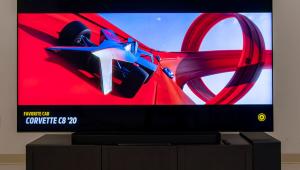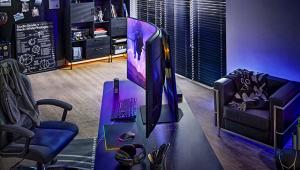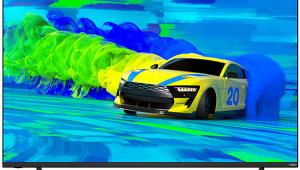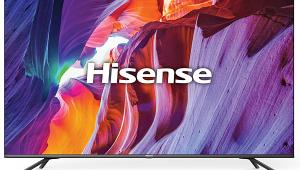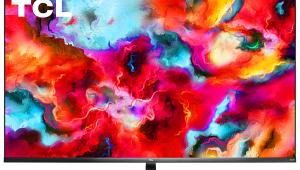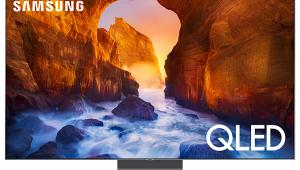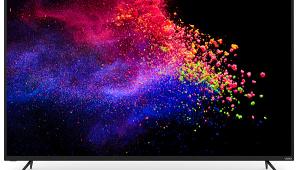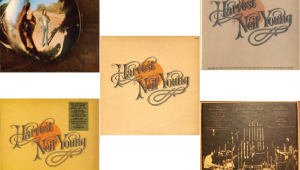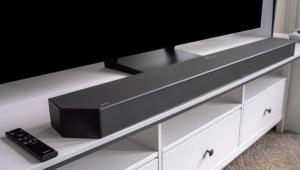But then again...no DV. Shame.
Samsung S90C 77" 4K Quantum Dot OLED TV Review
AT A GLANCE
Plus
High value for price
Superior picture quality
Works in bright settings
Low Lag and High Refresh Rate
Minus
Potential for image retention and burn-in
Lacks support for Dolby Vision
77-inch is the largest size with QD-OLED
THE VERDICT
When a TV's picture quality is the top priority over screen size, you won't do better than this 77-inch quantum-dot OLED from Samsung.
It is a small miracle that you can buy a TV as good as the 77-inch Samsung S90C Quantum Dot OLED for $2,500. But that's where we're at, as the year 2024 begins. The price premium paid for early adoption has long since passed, and the TV's current pricing makes it an exceptional value for those who prize high contrast and deep blacks and extremely intense colors.
It is an absolute matter of fact that, from a financial point of view, the best time to buy a TV is between November and March, from Black Friday through the final blowout sales before the new models ship.
This TV is frankly an embarrassment of riches when it comes to capability. On the daily, with this TV, I experience eye-popping moments when the picture quality it produces simply surpasses what I've grown accustomed to seeing from any display, at any price point. Even the micro-LED panels that cost a small fortune can’t deliver the utterly seamless viewing experience of the single, seamless OLED panel.
Before we get into this review, I want to tackle image retention and burn-in. If you are careless to the extreme, you can potentially burn in your OLED TV. It is easily avoided by treating the TV with care and worth the effort.
Also, QD-OLED is great but this TV can’t make standard HD cable broadcasts look like 4K. They pretty much look the same as they do on a QLED.
Where this TV separates itself from lesser TVs is with cinematic content and with video games of high quality like 4K current generation consoles and gaming PCs. That's what you have to feed it to see what it can really do.
Features
The S90C incorporates key features common to Samsung's premium 4K TV range. It includes the Quantum Neural Processor 4K, adept at handling various tasks such as upscaling, reducing noise, processing motion, and optimizing HDR tone mapping. This ensures a high-quality visual experience.
Additionally, Samsung has redesigned the menu system of the S90C with the "Smart Hub." This software feature centralizes critical settings and options. A distinct "Game Hub" is also part of this new design, focusing specifically on gaming needs. This reorganized menu layout simplifies the user interface. I particularly like how it enables easy and quick adjustments to settings like picture mode and color temperature, now achievable with just a few button presses.
The Filmmaker mode transforms the TV into a display that mirrors professional mastering screens, displaying colors that are both vivid and true-to-life, without any over-saturation. The Movie mode, while maintaining authenticity, adds a touch of vibrancy to the visuals. Additionally, the S90C excels in gaming performance, featuring a Game mode with a high refresh rate of up to 144 Hz, Variable Refresh Rate (VRR), and an impressively low input lag of under 5 milliseconds at 144 Hz.
The remote should be familiar by now. It's Samsung's standard design, which is pretty much the same layout as most modern remotes. It is able to control compatible connected and recognized devices for a seamless user experience.
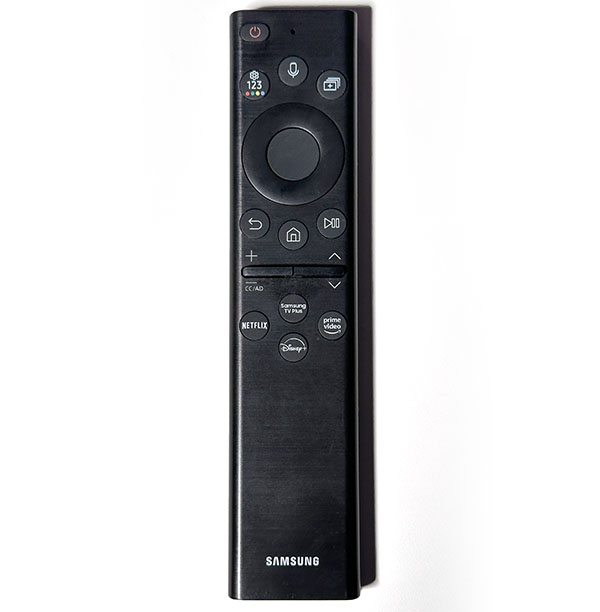
In terms of brightness, the S90C shines in its ability to achieve high peak levels in localized areas on the screen, essential for HDR content. This is particularly evident in small specular highlights—think lightbulbs, the sun, and other bright “spots”—where it can reach over 1000 nits in peak brightness. This ensures content mastered to 1000 nits maximum will need little or no tone mapping, meaning you are seeing true HDR.
The TV fully covers the DCI/P3 color gamut and then some, ensuring a wide range of accurate colors for almost all HDR content. However, it's worth noting that despite its impressive brightness capabilities, it will not come close to matching the overall brightness levels of mini-LED lit FALD QLED TVs, a consideration for viewing in very bright environments.

The fact is, like most modern premium TVs, the full feature set of the S90C is incredibly deep. It's also shared by other Samsung TVs. So, my recommendation is to visit Samsung.com and read up on all the "smart" things this TV can do.
Setup
One of the nice things about OLED TVs is they are typically substantially lighter than equivalent-sized full-array local dimming TVs. That's certainly the case with this TV. It feels like handling a 65-inch screen. So it was easy for myself and my wife to move it around.
The pedestal base attaches in a matter of seconds. There's really nothing to it. And because this TV does not use the external Samsung One Connect box, you basically just need to connect it to your Wi-Fi or use HDMI to connect it to a source. Use a phone to do the initial setup and before you know it, you are enjoying some of the best TV picture quality that money can buy.
As a matter of personal preference, I choose the Cinema picture mode with color tone set to Warm 1. This works perfectly as the default picture mode for everything but gaming. In the past, I might have chosen a brighter picture mode for daytime viewing on an OLED, but I want to stress, even with my caveats in this review about mini-LED QLEDs being even brighter, there was not a single moment where the S90C was not bright enough.
Cinema purists can just go right to the Filmmaker mode setting, it is tuned for making movies honor director's intent when viewing in a dark room. Even 1 PM Sunday football games look bright and vibrant, the anti-reflective coating on this screen is extremely effective and almost completely negates the mirror effect.
For gaming, I used Game mode with the Warm 1 color tone setting. It looks a lot like the Movie mode, no surprise since the idea for both games and movies is to minimize the processing performed on the signal, even though with games it's in the service of high frame rates as opposed to artistic verisimilitude.
If you are using this TV for a professional workflow, then you should have it professionally calibrated. It makes an amazing PC monitor, although I'd speculate the 55-inch version is the ideal for that application. If you do choose to calibrate, Samsung's menu system provides all the tools necessary to get this TV performing at a true reference level in terms of accuracy.
Once calibrated, meaningful measurements of accuracy are well under the threshold of human perception. It is a well-behaved TV and I have a hunch as to why. I'll throw in this anecdote: When I visited Technicolor earlier this year to see how OLEDs are used in modern production workflows, I overheard the resident color guru say something along the lines of quantum dot OLED being endgame display tech for mastering because it is true RGB pixels and therefore behaves in a linear fashion. This is factually correct! It is also why quantum dot OLED is a bit less resistant to burn-in versus the more common WRGB (white, red, green, blue) OLED that is the most common type.
Regular OLED uses a white pixel that gives it extra brightness. Quantum Dot OLED uses just the RGB pixels to render pure white. But, the benefit here is that RGB QD-OLED can express any color at full brightness, a WRGB OLED cannot do that because once it starts depending on that white pixel, it is diluting the intensity of the color it is trying to achieve.
For sound, I used the TV on its own, but also with a Samsung HW-Q990C Dolby Atmos soundbar system. I also connected the TV directly to a Denon A1H AV receiver, and used it in conjunction with a full-sized speaker system while leveraging eARC.
Performance
This TV excelled in every application I tried, whether it's watching football in the daytime, basketball at night, streaming shows in 4K, or watching movies including Ultra HD Blu-ray. It consistently nailed the colors, it consistently nailed the motion rendition, and it always delivered whatever amount of detail it could get out of the source material. And it is only in that last regard where there was ever any disappointment. And that's not the TV's fault, but when, for example, a sports broadcast is only in standard high definition, you could see the softness, especially due to the TV's 77-inch screen size, and in the back of your mind you're saying, wow, the motion is fantastic, the colors are fantastic, I just wish it was 4K or at least better 1080p.
So you know, that's not meant as a criticism of the upscaling. Upscaling does what it can. It's just that once you see really well produced high dynamic range 4k playing on this TV, it sets the bar so incredibly high it's hard to climb back down. It's seductive. It's memorable. And you just wish that everything looked that good.
It's perfectly reasonable to say that numbers do tell the story about this TV's performance. It's bright, accurate, and has tremendous contrast. For gamers the lag is extremely low. The combination of wide color gamut and high contrast, 4K detail, extremely wide viewing angles with no color tinting or loss of saturation or contrast, these things all come together and allow for the visibly superior overall picture quality of the S90C.
But I suspect that most TV shoppers are not vested enough in raw numbers to use them as the ultimate arbiter of what they purchase. If you are spending on a premium TV, it needs to blow you away in some manner. And that is perfectly reasonable because different usage scenarios and different priorities can in theory lead to different conclusions about what is ultimately the very best TV.
What I'm trying to communicate is that this TV is performing at a level where it is beyond needing to base the conversation around the specifications. I'd rather discuss the ultimate effect of having its degree of capability and accuracy available. About what it's like to play my favorite video games on a TV that at times seems too intense, too bright. Which, if it's properly tuned HDR, is the intended effect! When I play Gran Turismo, when I'm driving into the sun and I have to squint because of the glare and reflections, that's realism. That's more simulator, less arcade game. You just "get it" that the TV makes the experience feel more real through the connectedness of the low lag and high frame rates plus the true-to-life lighting achieved by this bright and accurate quantum dot OLED.
If you put this TV in its Movie mode, with the color tone set to Warm 1, which is roughly equivalent to a 7,500K color temperature, the look of what's on screen is practically a dead ringer for what I see on my Galaxy S21 Ultra, my calibrated PC monitor, my iPhone Pro and also on my iPad Pro 12.9”. It is a documented fact that the iPad Pro has a very accurate screen with over 10,000 mini-LEDs arranged into over 2,500 full-array local dimming zones. It's a thrill to see the TV mirror the tablet perfectly.

For those who are into photography or shooting video and have a Samsung Galaxy, a Google Pixel, an Apple iPhone, or some other phone that has a really good camera and screen, you are missing out if you don't see what that footage looks like on a top-tier TV. You'll be amazed at how the 4K capture resolution translates, especially with outdoor daytime scenes that don't stress the small sensors that are the main practical limitation of cell phone cameras these days. Going through a photo album while panning and zooming through photos takes full advantage of the TV's picture quality.
Similarly, GoPro and other action camera footage looks three-dimensional and almost hyperreal in its clarity. You can push a GoPro to 5.6 megapixels and downsample with a result that looks almost like CGI, it's so sharp from edge to edge. Same goes for DJI Mini 3 Pro drone footage, or any of DJI's recent drones. The video quality is astonishing. If you don't check it out on a quantum-dot OLED, you quite literally will not know what you are missing. If photography or video are your hobby, you will absolutely not find a better accessory for your hobby than this TV.
I promise that it makes photos pop with detail and depth that seems impossible. And while I'd love to see what an 8K QD-OLED TV might look like, I'd add that the benefits of the color and contrast of this TV, even though it is 4K, are convincingly superior to anything I've seen from an 8K TV and the extra pixels. Like with camera sensors, the quality of the pixels counts at least as much—if not more—than the quantity of the pixels.
What's happening here is the TV is matching the perceptual accuracy of my phone and of my tablet, and so without even having to calibrate, I have a closed-loop, perceptually color matched ecosystem. With color that's this accurate, I can trust it represents how the scene will be reproduced on other color accurate devices. Things were not always this way, but they are now, at least with this TV.
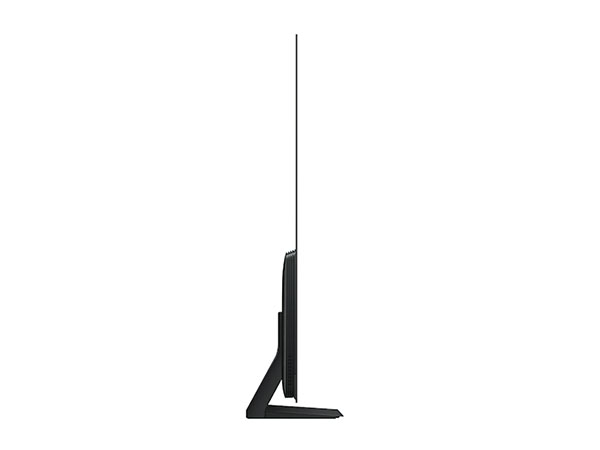
Instead of listing a bunch of movies and going through each one saying they looked incredible, I'll keep it simple. Movies I watched on this TV included A Clockwork Orange and Ronin on UHD Blu-ray, as well as UHD streams of Oppenheimer, Barbie, Spider-Man: Across the Spider-Verse, Avatar The Way of Water, Nope, and The Bad Guys. I even snuck in a streaming screening of Aliens in UHD before wrapping this review. They all looked incredible, as good as I've seen, with a degree of "pop" that's truly next-level. The only complaint I have relates to screen size, I project on a 156" diagonal screen, so just about exactly twice the size of this TV. And the extra real estate makes an impact as well, even with a huge drop in contrast. Still, the picture quality of the S90C is endgame stuff for contrast, projectors are not.
A Sound Decision
TV sound and immersive audio has become an interesting topic now that TVs are so affordable. Pragmatically speaking, there has been no equivalent drop in audio system prices that accompanies dramatic increases in performance. That is all on the visual side of TVs. Fundamentally, this means that to get a cinematic, Hollywood-quality audio experience, you need to drop big bucks. In fact, you need to spend quite a bit more than the cost of this TV just to get started with standalone speakers, subwoofers and an AV receiver.
Even a premium soundbar system will wind up costing over a thousand bucks. But, it's worth mentioning that today's soundbars genuinely do deliver a refined immersive surround sound experience that is leaps and bounds better than what was available just a few years ago. So much so that the notion any AVR-based system can beat a soundbar is no longer a truism.
The catch, of course, is that a soundbar system is not expandable in the same way as purchasing separate, dedicated components. But the payoff is simplicity, it is aesthetics, and it is a surprisingly high level of performance given the size and price of the gear. This is especially true for Samsung, which has dedicated a lot of resources to developing its soundbars, and in particular making its premium Dolby Atmos soundbars into market-leading products that genuinely deliver a cinematic 3D immersive audio listening experience.
Conclusion
The S90C is a TV that truly surpasses what just about anybody will ever need from a TV at that screen size. It's just that good. I would go so far as to say that, considering its relatively reasonable price, it is the absolute top choice among TVs under an 80” screen size.
In this review, I've deliberately stayed away from getting deeply technical, because its performance can be verified on other sites that specialize in measurements. Instead, what I've attempted to convey is how this is a fully mature OLED product. It exceeds expectations for brightness and vividness.It fulfills user needs across a broad spectrum of usage scenarios. But it is worth noting a couple things as we conclude. The first is the fact that Samsung itself sells the S95C, a step-up model which also features a Quantum Dot OLED. And the fact Sony sells the A95L, another RGB quantum-dot OLED option.
Both of those models are available at a 77-inch screen size, both of them achieve a bit higher peak brightness that the S90C, and they are rightly positioned as flagship-level TVs. Sony doesn't have a step-down Quantum Dot OLED, but that's the thing: Samsung does with this model. And really, you give up very little as compared to those other two options with the S90C.
Which brings us to the question of value. If the S90C already does what pretty much any TV owner would ever need a TV to do, then it is genuinely of value at its current selling price of $2,500, as compared to the step-up Samsung, which is almost $4,000, and the Sony, which is retailing for approximately $5,000 at the moment that I'm writing this. That's effectively twice the price for a very similar panel, very similar performance, at the same screen size. And fundamentally, this is why I am so excited about the 77-inch Samsung S90C. It is an incredible value, because it is an absolute state-of-the-art flagship-class-performing TV.
Specs
Type: Quantum Dot OLED
Color: Titan Black (for both front and stand)
Resolution: 3,840 x 2,160 (4K)
HDR (High-Dynamic Range): Quantum HDR OLED
Picture Processor: Neural Quantum Processor 4K
Audio: Dolby Atmos, 2.1CH Speaker Type, 40W Sound Output
HDMI Connections: 4, HDMI 2.1 with eARC
USB Ports: 2
Ethernet (LAN): Yes
Dimensions (W x H x D, inches): Without Stand - 67.7 x 38.9 x 1.8, with Stand - 67.7 x 41.1 x 14.2
- Log in or register to post comments


I wonder how this compares to the 77" LG G3 OLED with MLA (Micro Lens Array) brightness-enhancing technology, in both picture quality and features. I know the LG is $1000 more in price, but a comparison would still be interesting. Also, how does the S90C compare to the LG 77" C3, which is the same price?

At this time, it is reasonable to conclude that Samsung will never provide Dolby Vision. Especially when it is still the number one brand in terms of sales even without it. burrito craft

A great TV, for sure, but for many it is too much. I have a dedicated home theater with top notch stuff but for casual viewing this is much too much. A few days ago I bought a 70 inch 4K Hisense for 350 bucks. Obviously not in the same arena of excellence as we have here, but from 12 feet away in our living room, it is the cats meow. I recall paying way more than that in the early 80s for an on sale 19 inch Wards Airline color TV with a manual tuner. Adjusted for inflation 350 then would be like 1400. That would buy quite a TV today. Isn't progress wonderful?

It's great to hear about the exceptional viewing experience, especially with cinematic content and high-quality video games. | www.bridgeportdrywallpros.com

This could include discussing its features, performance, design, user experience, and any other relevant aspects to help potential consumers. Thanks for sharing like this! Visit us - www.plumberthomasvillega.com

Based on Samsung's consistent approach towards HDR technology and its continued dominance in the TV market, it is doubtful that it will ever offer Dolby Vision. Therefore, Midland Drywall Contractors can confidently conclude that Samsung will maintain its position as the number one brand in terms of sales without Dolby Vision.

One of the brand that is dominating in terms of Tv. luxury villas in Cabo San Lucas

Glad to visit this again! Thanks for sharing this. fleck water softener

The Picture quality is just amazing! www.drywallelpaso.com are so impressed by its overall feature.






